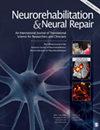中风后皮质脊髓和皮质内兴奋性的改变:带 Meta 分析的系统回顾。
IF 3.7
2区 医学
Q1 CLINICAL NEUROLOGY
引用次数: 0
摘要
目的:本荟萃分析旨在研究运动阈值(MT)、运动诱发电位(MEP)、短时皮质内抑制(SICI)和皮质内促进(ICF)的变化,并使用机器学习方法确定研究变异性的来源。方法:我们确定了使用经颅磁刺激客观评估脑卒中后皮质脊髓兴奋性和皮质内抑制/促进的研究。计算了受试者内(即受影响半球 [AH] vs 未受影响半球 [UH])和受试者间(即 AH 和 UH vs 对照组)的标准化平均差。结果共纳入 35 项研究(625 名中风患者和 328 名健康对照组)。与 UH 和对照组相比,AH 的 MT 明显增加,MEP 明显减少(即兴奋性降低)(P < .01)。与 UH 相比,AH 的 SICI 增加(即抑制降低),与对照组相比,AH 和 UH 的 SICI 增加(即抑制降低)(P < .001)。与 UH 相比,AH 的 ICF 明显增加(即促进作用增加)(P = .016),而与对照组相比,UH 的 ICF 则减少(P < 0.001)。决策树表明,人口统计学和方法学因素可准确预测(73%-86%)显示皮质脊髓和皮质内兴奋性指标发生改变的研究。SICI 和 ICF 的改变可能反映了中风后运动皮层的抑制消失,这与中风增加患侧抑制的观点相反。本文章由计算机程序翻译,如有差异,请以英文原文为准。
Altered Corticospinal and Intracortical Excitability After Stroke: A Systematic Review With Meta-Analysis.
BACKGROUND
Intracortical inhibitory/faciliatory measures are affected after stroke; however, the evidence is conflicting.
OBJECTIVE
This meta-analysis aimed to investigate the changes in motor threshold (MT), motor evoked potential (MEP), short-interval intracortical inhibition (SICI), and intracortical facilitation (ICF), and identify sources of study variability using a machine learning approach.
METHODS
We identified studies that objectively evaluated corticospinal excitability and intracortical inhibition/facilitation after stroke using transcranial magnetic stimulation. Pooled within- (ie, affected hemisphere [AH] vs unaffected hemisphere [UH]) and between-subjects (ie, AH and UH vs Control) standardized mean differences were computed. Decision trees determined which factors accurately predicted studies that showed alterations in corticospinal excitability and intracortical inhibition/facilitation.
RESULTS
A total of 35 studies (625 stroke patients and 328 healthy controls) were included. MT was significantly increased and MEP was significantly decreased (ie, reduced excitability) in the AH when compared with the UH and Control (P < .01). SICI was increased (ie, reduced inhibition) for the AH when compared with the UH, and for the AH and UH when compared with Control (P < .001). ICF was significantly increased (ie, increased facilitation) in the AH when compared with UH (P = .016) and decreased in UH when compared with Control (P < 0.001). Decision trees indicated that demographic and methodological factors accurately predicted (73%-86%) studies that showed alterations in corticospinal and intracortical excitability measures.
CONCLUSIONS
The findings indicate that stroke alters corticospinal and intracortical excitability measures. Alterations in SICI and ICF may reflect disinhibition of the motor cortex after stroke, which is contrary to the notion that stroke increases inhibition of the affected side.
求助全文
通过发布文献求助,成功后即可免费获取论文全文。
去求助
来源期刊
CiteScore
8.30
自引率
4.80%
发文量
52
审稿时长
6-12 weeks
期刊介绍:
Neurorehabilitation & Neural Repair (NNR) offers innovative and reliable reports relevant to functional recovery from neural injury and long term neurologic care. The journal''s unique focus is evidence-based basic and clinical practice and research. NNR deals with the management and fundamental mechanisms of functional recovery from conditions such as stroke, multiple sclerosis, Alzheimer''s disease, brain and spinal cord injuries, and peripheral nerve injuries.

 求助内容:
求助内容: 应助结果提醒方式:
应助结果提醒方式:


